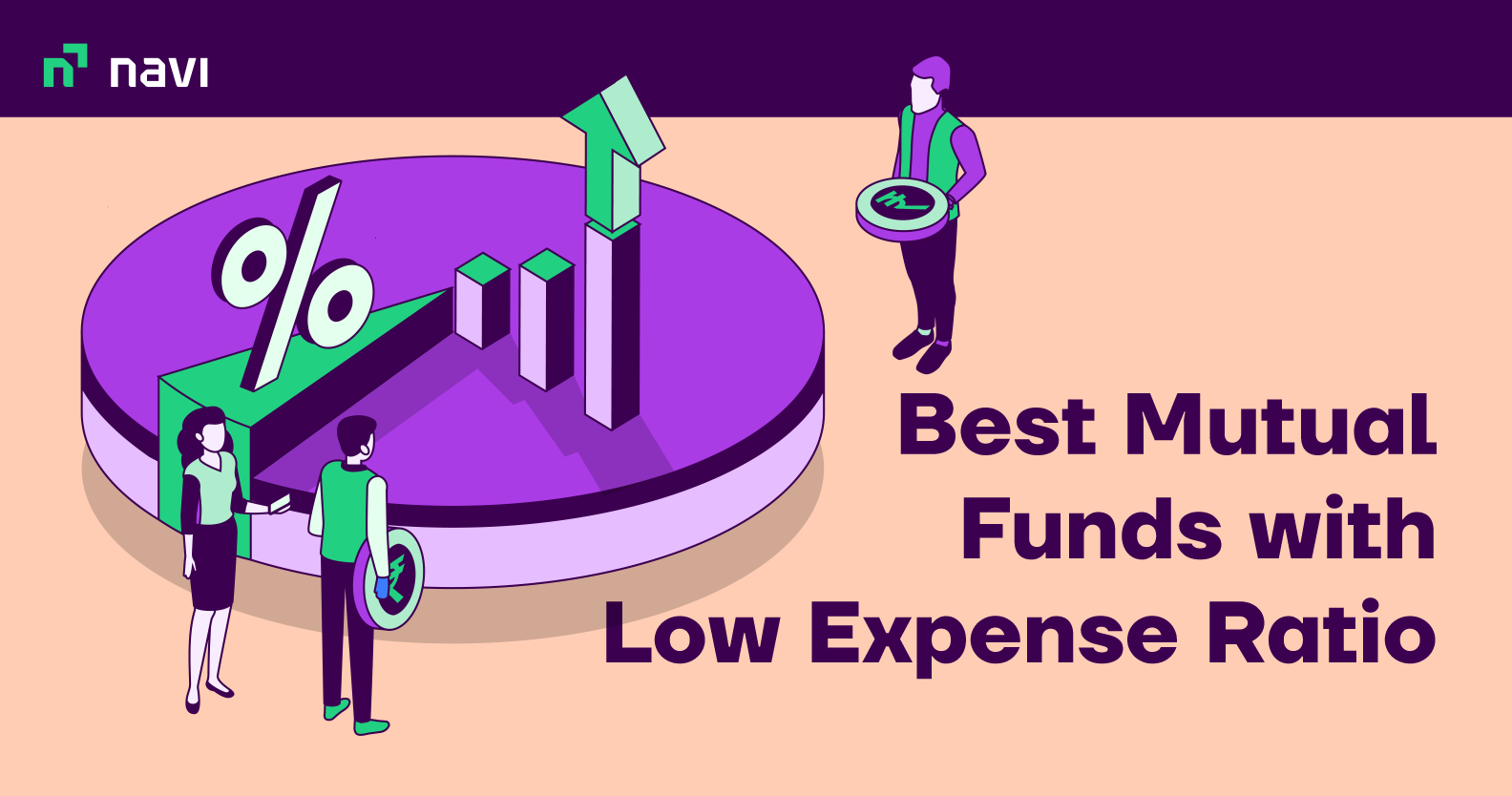10 Best Mutual Funds With Lowest Expense Ratio in April 2023

The expense ratio is a critical factor to consider before investing in mutual funds. It is an annual maintenance fee fixed by mutual funds to cover expenses such as operational costs, management fees, advertising costs etc. It’s important to remember that higher the expense ratio of a fund, the lower the returns on its assets.
In this blog we shall explore more about the best mutual funds with low expense ratio 2023, before making an investment. Let’s begin!
What is a Low Expense Ratio?
To begin, let us first understand Expense Ratio, as defined by the AMC (Asset Management Company) charges investors a fee for managing their investments. This amount covers handling expenses, administrative expenses and operating costs. Generally, it is a percentage of the total amount invested by an investor and is referred to as Total Expense Ratio (TER).
The expense ratio is completely under the purview of the country’s market regulator, Securities and Exchange Board of India (SEBI). It has specified a category-wise list of expense ratios for mutual funds that fund houses need to follow.
Typically, the expense ratios of equity funds are higher than debt funds while active funds carry higher costs than passively-managed funds. If we look at it from the investor’s perspective, a good or low expense ratio falls in the range of 0.5% and 0.75% for an actively managed mutual fund.
Top 10 Mutual Funds with Low Expense Ratio
The table below represents the best mutual funds with low expense ratios 2023:
| Name of Mutual Funds | Expense Ratio |
| WhiteOak Capital Tax Saver Fund Direct-Growth | 0.34% |
| IIFL ELSS Nifty 50 Tax Saver Index Fund Direct-Growth | 0.27% |
| Navi ELSS Tax Saver Direct-Growth | 0.4% |
| ITI Long Term Equity Fund Direct-Growth | 0.44% |
| Indiabulls Tax Savings Fund Direct-Growth | 0.5% |
| Quant Tax Plan Direct-Growth | 0.57% |
| Mirae Asset Tax Saver Direct-Growth | 0.58% |
| Shriram Long Term Equity Fund Direct-Growth | 0.6% |
| Canara Robeco Equity Tax Saver Direct-Growth | 0.64% |
| Kotak Tax Saver Direct-Growth | 0.69% |
**This table is for illustrative purposes only. Mutual Funds are subject to market risk. Read all scheme related documents carefully before investing.
*Mutual Fund investments are subject to market risks, read all scheme-related documents carefully.
Also Read
Performance of Best Mutual Funds with Low Expense Ratio 2023
The following is a detailed overview of mutual fund expense ratio list
1. WhiteOak Capital Tax Saver Fund Direct-Growth
This scheme invests 98.27% in equity, 0.62% in debt securities and 1.11% in others. When it comes to sectoral allocation, WhiteOak Capital Tax Saver Fund invests 28.57% in the financial sector, 10.43% in technology, 8.46% in consumer staples, 8.43% in capital goods, 7.92% in materials and 36.19% in others. Provided below are more details:
- Fund Size: ₹39.24Crore
- NAV: ₹9.75
- Expense Ratio: 0.34%
- Risk: Very high risk
- Minimum Investment: SIP ₹500, Lump Sum ₹500
- Type of Fund: ELSS
- Annualised 1-Year Return: NA
- Annualised 3-Year Return: NA
- Annualised 5-Year Return: NA
2. IIFL ELSS Nifty 50 Tax Saver Index Fund Direct-Growth
This equity-linked savings scheme (ELSS) invests 36.20% in the financial sector, 13.91% in energy, 13.89% in technology, 8.53% in consumer staples, 5.31% in automobiles and 22.16% in others. The fund aims to replicate the performance of the Nifty 50 index with minimal tracking error and offer tax benefits. Given below are its details:
- Fund Size: ₹26.77 Crore
- NAV: ₹9.56
- Expense Ratio: 0.27%
- Risk: Very high risk
- Minimum Investment: SIP ₹500, Lump Sum ₹500
- Type of Fund: ELSS
- Annualised 1-Year Return: NA
- Annualised 3-Year Return: NA
- Annualised 5-Year Return: NA
3. Navi ELSS Tax Saver Direct-Growth
This equity-linked savings scheme was officially launched on December 30, 2015, and it invests 23.87% in the financial sector, 11.14% in healthcare, 10.79% in technology, 9.63% in automobiles, 7.84% in capital goods and 36.73% in other sectors. Since its launch, it has generated 12.24% in average annualised returns. Given below are more details:
- Fund Size: ₹56.91 Crore
- NAV: ₹22.47
- Expense Ratio: 0.4%
- Risk: Very high risk
- Minimum Investment: SIP ₹500, Lump Sum ₹500
- Type of Fund: ELSS
- Annualised 1-Year Return: 0.85%
- Annualised 3-Year Return: 25.76%
- Annualised 5-Year Return: 10.56%
4. ITI Long Term Equity Fund Direct-Growth
This equity-linked savings scheme has generated an average annualised return of 12.76% in the past 4 years from the date of launch. It invests 31.33% in the financial sector, 9.46% in technology, 9.42% in energy, 7.61% in services, 6.50% in materials and 35.68% in others. More details are as follows:
- Fund Size: ₹156.23 Crore
- NAV: ₹14.82
- Expense Ratio: 0.44%
- Risk: Very high risk
- Minimum Investment: SIP ₹500, Lump Sum ₹500
- Type of Fund: ELSS
- Annualised 1-Year Return: 6.82%
- Annualised 3-Year Return: 25.81%
- Annualised 5-Year Return: NA
5. Indiabulls Tax Savings Fund Direct-Growth
The Indiabulls Tax Savings Fund was introduced on December 28, 2017, and invests 33.57% in the financial sector, 10.37% in technology and 10.15% in energy stocks. It also has exposure in consumer staples and automobiles. Since its launch, it has delivered an average annualised return of 7.29%. Given below are its details:
- Fund Size: ₹36.36 Crore
- NAV: ₹14.17
- Expense Ratio: 0.5%
- Risk: Very high risk
- Minimum Investment: SIP ₹500, Lump Sum ₹500
- Type of Fund: ELSS
- Annualised 1-Year Return: 0.93%
- Annualised 3-Year Return: 23.13%
- Annualised 5-Year Return: 7.89%
6. Quant Tax Plan Direct-Growth
Quant Tax Plan invests 24.24% in the financial sector, 16.33% in consumer staples, 11.99% in energy, 11.88% in services, 8.15% in materials and 27.41% in other sectors. This scheme was launched on January 7, 2013, and since then, it has delivered average annual returns of 20.22% and is one of the lowest expense ratio mutual funds. For more details, look at the following list:
- Fund Size: ₹2779.06 Crore
- NAV: ₹246.69
- Expense Ratio: 0.57%
- Risk: Very high risk
- Minimum Investment: SIP ₹500, Lump Sum ₹500
- Type of Fund: ELSS
- Annualised 1-Year Return: 0.53%
- Annualised 3-Year Return: 51.33%
- Annualised 5-Year Return: 22.51%
7. Mirae Asset Tax Saver Direct-Growth
The Mirae Asset Tax Saver Fund invests 33.07% in financials and also has exposure in technology, energy, healthcare, automobiles and other sectors. It was officially launched on December 28, 2015, and since then, it has delivered average annualised returns of 18.67%. Check below for more details:
- Fund Size: ₹14043.04 Crore
- NAV: ₹33.40
- Expense Ratio: 0.58%
- Risk: Very high risk
- Minimum Investment: SIP ₹500, Lump Sum ₹500
- Type of Fund: ELSS
- Annualised 1-Year Return: – 0.07%
- Annualised 3-Year Return: 31.99%
- Annualised 5-Year Return: 15.67%
8. Shriram Long Term Equity Fund Direct-Growth
This equity-linked savings scheme has exposure in technology, energy, healthcare, chemicals, automobile and financial sectors. Since its launch on January 25, 2019, it has generated an average annualised return of 12.85%. Like the other ELSS on this list, it aims to provide long-term capital appreciation and tax benefits under Section 80C. Check below for more details:
- Fund Size: ₹36.69 Crore
- NAV: ₹16.12
- Expense Ratio: 0.6%
- Risk: Very high risk
- Minimum Investment: SIP ₹500, Lump Sum ₹500
- Type of Fund: ELSS
- Annualised 1-Year Return: 0.54%
- Annualised 3-Year Return: 21.10%
- Annualised 5-Year Return: NA
9. Canara Robeco Equity Tax Saver Direct-Growth
The Canara Robeco Equity Tax Saver fund was launched on January 2, 2013, and it has delivered 14.96% average annualised returns since then. This ELSS has 33.44% exposure in the financial sector, followed by 9.47% in technology, 7.09% in automobiles, 5.98% in healthcare, 5.71% in energy and 38.31% in others. Recently, its CRISIL rank has been updated from 3 to 4. More details are as follows:
- Fund Size: ₹4685.85 crore
- NAV: ₹122.89
- Expense Ratio: 0.64%
- Risk: Very high risk
- Minimum Investment: SIP ₹500, Lump Sum ₹500
- Type of Fund: ELSS
- Annualised 1-Year Return: 0.81%
- Annualised 3-Year Return: 29.19%
- Annualised 5-Year Return: 15.59%
10. Kotak Tax Saver Direct-Growth
This equity-linked savings scheme invests 27.53% in the financial sector, 8.65% in automobiles, 7.61% in consumer staples, 7.38% in capital goods, 6.10% in technology and 42.82% in others. Since its inception on January 2, 2013, it has generated an average annual return of 15.01%. In the last quarter, its CRISIL rank has improved to 5 from 4. Details of this fund are as follows:
- Fund Size: ₹3167.04Crore
- NAV: ₹84.29
- Expense Ratio: 0.69%
- Risk: Very high risk
- Minimum Investment: SIP ₹500, Lump Sum ₹500
- Type of Fund: ELSS
- Annualised 1-Year Return: 3.66%
- Annualised 3-Year Return: 30.70%
- Annualised 5-Year Return: 14.58%
Calculate Your Mutual Fund Returns
Total Investment
Expected return rate (p.a)
%
Time Period (Years)
Invested Amount
0
Est. Returns
Total Value
How to Choose Mutual Funds Having Low Expense Ratio?
One of the most important factors that investors must consider before investing in a mutual fund is its expense ratio. Fund houses charge a fee for covering the expenses associated with running a mutual fund scheme. SEBI has maintained an upper ceiling in terms of levying an expense ratio. No fund house can charge an expense ratio exceeding 2.25%. Therefore, individuals must thoroughly read the terms and conditions, which contain all details about these operating costs. An individual looking to stay invested in the long term must choose the mutual fund with lower expense ratios as higher fees will have a compounding effect and will severely affect net proceeds.
Example:
Mr Yadav wants to invest in a large-cap fund for 20 years. He has confusion between two established fund houses, both offering similar returns. One offers a return of 12.5% per annum, whereas the other offers a return of 13%. Now, the first fund house charges an expense ratio of 0.75%, whereas the latter charges an expense ratio of 2%. This means that the net return in the first fund will amount to 11.75%, and in the second fund, it will be 11%. Although the first mutual fund scheme has a lower annual return potential than the second one, he should always go for the first one because of the lower expense ratio in the first scheme. Hence, one must do market research and go for the lowest expense ratio mutual fund.
Who Should Invest in Mutual Funds with Lowest Expense Ratio?
Given below are the investors who will want to invest in mutual funds with the lowest expense ratios:
- People who wish to earn maximum returns from their mutual fund investments should invest in funds with low expense ratios.
- Investors who want to reduce their total investment costs can consider investing in the best mutual funds with low expense ratios.
- Another important point to consider is that a high expense ratio does not guarantee better fund performance. For two mutual funds with similar returns, the one with the lower expense ratio will deliver more returns and this accumulates over time. So, investors who are aware of this fact can shortlist mutual funds with low expense ratios.
Also Read
Benefits of Low Expense Ratio Mutual Funds
- One of the biggest benefits that an investor reaps with a mutual fund with a low expense ratio is the potential to earn better returns on their investments.
- As fund houses deduct the operating fees from investors’ realised value and transfer the net proceeds into their bank accounts, low costs could lead to higher returns and vice versa.
- A low expense ratio will allow higher wealth accumulation at a swift pace. It will therefore help investors in fulfilling their investment goals within the investment timeframe.
Taxation on Income from Mutual Funds with Lowest Expense Ratio
Mutual funds with low expense ratios are taxed according to their underlying securities. If the equity component is higher, these schemes will be taxed like equity funds. On the other hand, debt fund taxation rules will be applicable if the debt component is higher. Given below are the important points:
- If an investor holds units of an equity fund for less than 12 months, then taxation rules for short-term capital gains (STCGs) will be applicable. STCGs are taxed at 15% plus 4% cess.
- If equity funds are held for more than 12 months, then it is classified as long term capital gains (LTCGs) and the applicable tax rate is 10% plus 4% cess. LTCGs up to ₹1 lakh are entirely tax-free.
- When it comes to debt funds, investors need to hold their units for at least 36 months for the capital gains to be classified as STCGs. These gains are added to the investor’s income and taxed according to their income tax slab rate.
- If the holding period of a debt fund investment exceeds 36 months, the capital gains are classified as LTCGs and taxed at 20% with indexation.
- When people invest in ELSS, they can receive tax benefits under Section 80C of the Income Tax Act. To be precise, ELSS investors can seek tax deductions of at most ₹1.5 lakh in a financial year, thus saving ₹46,800 in taxes. Moreover, there is no restriction with respect to the maximum amount that can be invested.
Final Word
As discussed above, the expense ratio is one of the most important factors that an investor should consider before choosing a mutual fund to invest in. For the benefit of investors, we have provided the details of the ten best mutual funds with low expense ratios 2023. But, investors should do thorough market research to choose a fund with a low expense ratio.
In case you’re looking for low expense ratio mutual funds, explore Navi Mutual Fund. Invest in low-index mutual funds with Navi!
FAQs
There are three main components of expense ratio – management fees, administrative costs and promotional expenses. Management fees are professional remuneration paid to fund managers for managing a mutual fund scheme. Fund houses hire professional fund managers who bring experience and expertise with them to handle tough scenarios. However, they need to be paid hefty remuneration to come on board.
Administrative costs cover the day-to-day running expenses of these mutual fund schemes. It includes customer support expenses, records storage and collection expenses, office infrastructure expenses, and costs incurred in research and analysis of various securities.
Yes, there are other charges that a fund house can levy on its investors. It includes advisory charges and exit load. Advisory charges are over and above the expense ratio and levied by fund houses as consultancy fees. Exit loads are redemption charges that a fund house levies on investors if they wish to withdraw from the fund before a stipulated date.
If investors are concerned about paying high expense ratios, then they can go for passive mutual funds like index funds or ETFs. These are passively managed, and hence a manager has a very limited role in generating returns, so they have very low expense ratios.
Index fund is a category of mutual fund which replicates an index like the Nifty 50 or Sensex. Fund managers in these funds create a portfolio with similar weightage for stocks listed on a particular index. The Net Asset Value of these funds fluctuates as per movements in stock exchanges.
Want to put your savings into action and kick-start your investment journey 💸 But don’t have time to do research? Invest now with Navi Nifty 50 Index Fund, sit back, and earn from the top 50 companies.
Disclaimer: Mutual Fund investments are subject to market risks, read all scheme-related documents carefully.
This article has been prepared on the basis of internal data, publicly available information and other sources believed to be reliable. The information contained in this article is for general purposes only and not a complete disclosure of every material fact. It should not be construed as investment advice to any party. The article does not warrant the completeness or accuracy of the information and disclaims all liabilities, losses and damages arising out of the use of this information. Readers shall be fully liable/responsible for any decision taken on the basis of this article.

Customer’s Feedback
No comments found.10 Best Demat Accounts in India for Beginners in 2023
Creation of Demat accounts revolutionised the way trades were conducted at the stock exchanges. It... Read More »10 Best SIP Plans for 1000 Per Month in India 2023
Systematic Investment Plan (SIP) is an investment style or route with which you can invest a fixed ... Read More »How to Invest in Mutual Funds in India – Easy Steps
Mutual funds can be an excellent way to diversify your portfolio and gain exposure to a wide range ... Read More »20 Best Nifty 50 Index Funds in India to Invest in April 2023
What is the Nifty 50 Index Fund? Nifty 50 index funds are a type of passively-managed equi... Read More »Asset Management Company (AMC) – Types and Benefits
What is an Asset Management Company (AMC)? Asset Management Company or AMC is a financial ... Read More »10 Best Gold Mutual Funds to Invest in India (April 2023)
Gold Mutual Funds are funds that invest in gold and gold-related assets such as bullion, coin... Read More »20 Best Flexi Cap Mutual Funds to Invest in India 2023
Flexi-cap funds are mutual fund schemes that aim to invest in stocks of companies across market cap... Read More »Best SIP Plans for 15 years – Top 10 SIP Plans to Invest in India 2023
A systematic investment plan (SIP) could be a convenient mode or style of investing in mutual funds... Read More »10 Best SIP Plans for 1 year Investment in India 2023
There has been a massive surge in SIP or Systematic Investment Plan investors in recent years. As p... Read More »10 Best SIP Plan for 3 Years in India to Invest in 2023
SIP or Systematic Investment Plan helps bring investment discipline in an investor’s life. It’s... Read More »10 Best SIP Plan for 10 years India in 2023 – Returns and Performance
Ask any beginner mutual fund investor and most of them would tell you that their preferred mode of ... Read More »10 Best SIP Plans for 5 years in India to Invest in 2023
Systematic Investment Plan (SIP) could be an effective investment mode if you want to invest a fixe... Read More »Top 10 Chit Fund Schemes in India in 2023
Chit funds are one of the most popular return-generating saving schemes in India. It is a financial... Read More »10 Best Gold ETFs in India to Invest in April 2023
Gold ETFs or Gold Exchange Traded Funds are passively managed funds that track the price of physica... Read More »10 Best Demat Accounts in India for Beginners in 2023
Creation of Demat accounts revolutionised the way trades were conducted at the stock exchanges. It... Read More »20 Best Index Funds to Invest in India in April 2023
What is an Index Fund? An index fund is a type of mutual fund or exchange-traded fund (ETF) that... Read More »Best Arbitrage Mutual Funds to Invest in India in April 2023
Arbitrage funds are hybrid mutual fund schemes that aim to make low-risk profits by buying and sell... Read More »10 Best SIP Plans in India to Invest in April 2023
What is SIP? SIP or Systematic Investment Plan is a method of investing a fixed amount in ... Read More »10 Best Corporate Bond Funds in India to Invest in April 2023
Corporate bond funds are debt funds that invest at least 80% of the investment corpus in companies ... Read More »10 Best Bank for Savings Account in India [Highest Interest Rate 2023]
Savings account is a type of financial instrument offered by several banks. It lets you safely depo... Read More »

































